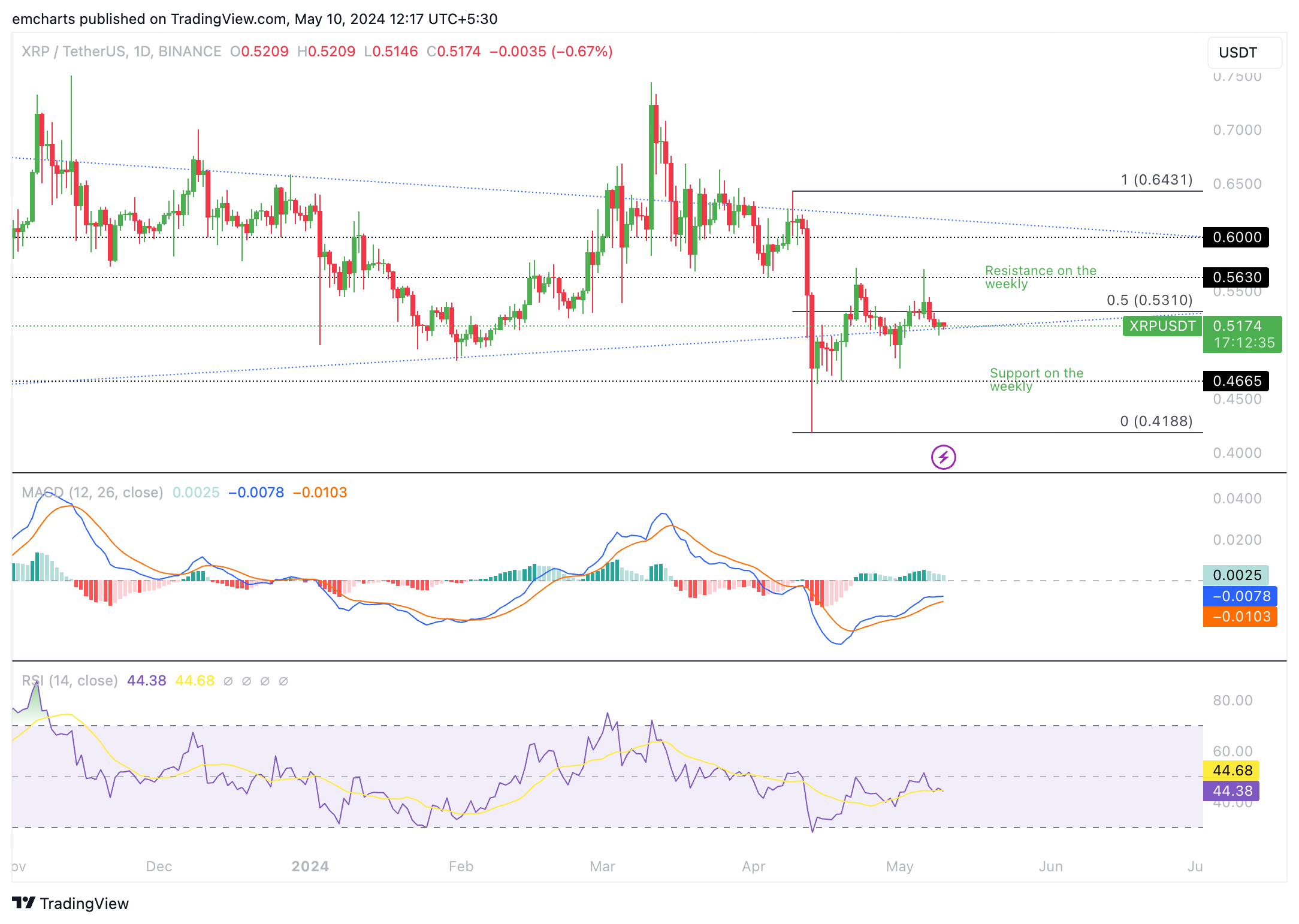- Ripple and XRPL Labs have joined the DeRec Alliance as founding members.
- The DeRec Alliance brings Web3 firms together to work on the recovery of digital assets in a secure manner across wallets.
- XRP tested support at $0.50 on Thursday, exchanging hands at $0.5174 on Friday.
XRP trades around $0.5174 early on Friday, wiping out gains from earlier in the week, as Ripple announced it has joined an alliance to support digital asset recovery alongside Hedera and the Algorand Foundation.
The other key catalyst influencing XRP price, which is testing critical support at $0.50, is the lawsuit that Ripple faces against the Securities and Exchange Commission (SEC) vs. Ripple over whether the sales of XRP to institutional investors are considered an unregistered sales of securities. The two parties have filed their motions, opposing motions and supporting evidence in the remedies phase, and now await a ruling on the penalties to be imposed on Ripple for this alleged violation of securities laws.
Daily Digest Market Movers: Ripple and XRPL Labs join alliance to support blockchain recovery
- Cross-border payment remittance firm Ripple announced on Thursday that it has joined an alliance (DeRec alliance) alongside Algorand Foundation and Hedera to support the recovery of digital assets in a secure manner. Ripple and XRPL Labs have joined as founding members and hold a two-year seat on the Technical Oversight Committee (TOC).
- The firm will provide input on the alliance’s governance structure and offer input on core policies to make the recovery of digital assets, accounts, passwords and other data, as simple as in Web2 ecosystems.
- The other market mover for XRP price is the lawsuit between Ripple and the SEC. The latest development in the legal battle is that the two parties have filed their motions, reply briefs and opposition to replies in the remedies phase. XRP holders await the court’s decision on the SEC’s demand for $2 billion in fines and Ripple’s counter of $10 million.
Technical analysis: XRP is likely to sweep liquidity at $0.46
The XRP price has fallen 2.7% so far this week, but it has maintained above the key support of $0.50, which aligns with a psychological level. Amid the sideways trend that Ripple has experienced in the last few weeks, momentum indicators can give clues about the next likely move.
Two important momentum indicators give contradictory views in XRP’s case. The Relative Strength Index (RSI) falls to around 40 in all three major charts (weekly, daily and 4-hour), suggesting that bullish momentum appears to be waning. However, the Moving Average Convergence Divergence (MACD) indicator shows green histogram bars above the neutral line, signaling a positive momentum in XRP price trend.
If selling pressure persists, Ripple is likely to suffer an 8% correction and sweep liquidity at the weekly support level at $0.4665 seen on April 19. Two key levels that have been respected since mid April stand out on the weekly time frame– support at $0.4665 and resistance at $0.5630.
XRP/USDT 1-day chart
A daily candlestick close above $0.53, the 50% Fibonacci retracement level of the decline from April 9 top of $0.6431 to the April 13 low of $0.4188, could invalidate the bearish thesis. In such a case, XRP would face the next resistance at $0.5630, the weekly resistance level set on April 6.
Bitcoin, altcoins, stablecoins FAQs
Bitcoin is the largest cryptocurrency by market capitalization, a virtual currency designed to serve as money. This form of payment cannot be controlled by any one person, group, or entity, which eliminates the need for third-party participation during financial transactions.
Altcoins are any cryptocurrency apart from Bitcoin, but some also regard Ethereum as a non-altcoin because it is from these two cryptocurrencies that forking happens. If this is true, then Litecoin is the first altcoin, forked from the Bitcoin protocol and, therefore, an “improved” version of it.
Stablecoins are cryptocurrencies designed to have a stable price, with their value backed by a reserve of the asset it represents. To achieve this, the value of any one stablecoin is pegged to a commodity or financial instrument, such as the US Dollar (USD), with its supply regulated by an algorithm or demand. The main goal of stablecoins is to provide an on/off-ramp for investors willing to trade and invest in cryptocurrencies. Stablecoins also allow investors to store value since cryptocurrencies, in general, are subject to volatility.
Bitcoin dominance is the ratio of Bitcoin’s market capitalization to the total market capitalization of all cryptocurrencies combined. It provides a clear picture of Bitcoin’s interest among investors. A high BTC dominance typically happens before and during a bull run, in which investors resort to investing in relatively stable and high market capitalization cryptocurrency like Bitcoin. A drop in BTC dominance usually means that investors are moving their capital and/or profits to altcoins in a quest for higher returns, which usually triggers an explosion of altcoin rallies.
Source
